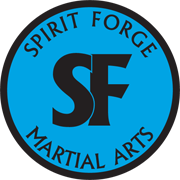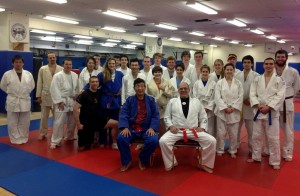I was Grandmaster Kyu Ha Kim’s student for more than twenty-eight years. Grandmaster Kyu Ha Kim was a remarkable human being, martial artist, and teacher who embodied what is best in martial arts. I wrote the following article in 2013 to honor him and chronicle his extraordinary life.
–Master Christopher D. Moore
Grandmaster Kyu Ha Kim
My Family grew rice on our farm in Korea. When the rice plants were young, they grew straight and tall. As they grew older and became heavy with rice, their heads bowed.
–Grandmaster Kyu Ha Kim
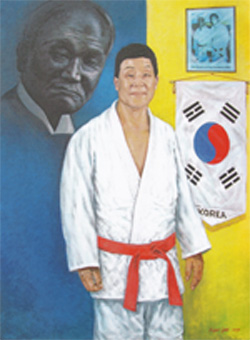
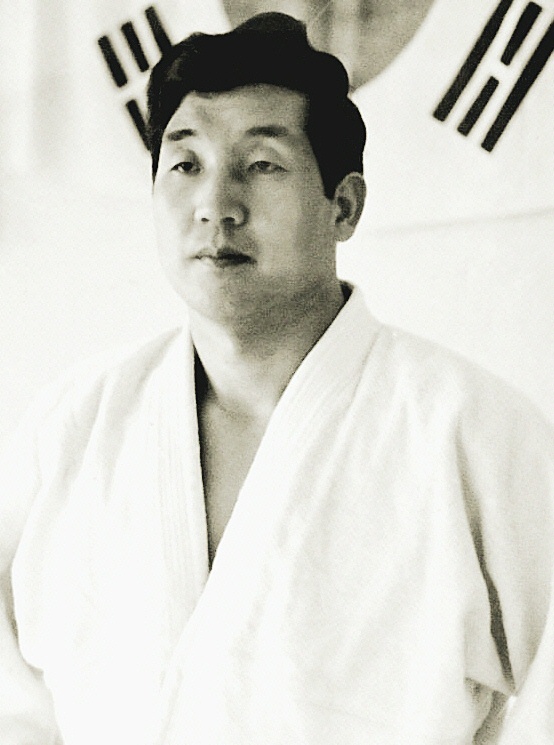
Grandmaster Kyu Ha Kim stands where he has stood for over fifty years, in front of a group of students patiently explaining the subtleties of a Judo technique. At just over seventy-eight years old, he has the erect carriage of a much younger man, the result of a lifetime of martial arts training. Standing six feet two inches tall and weighing two hundred thirty pounds, he is an imposing figure. Once described as a “large and joyous man,” he radiates kindness. His school in Brentwood, Pennsylvania echoes with the sound of his laughter. Quiet, humble and self-effacing, few of the students listening with rapt attention know that the kindly man standing before them is a martial artist of rare accomplishment- a 9th degree black belt in Judo and an 8th degree black belt in Taekwondo-or that in June of 2008, he became the oldest successful heart transplant recipient in the history of the University of Pittsburgh Medical Center.
Kyu Ha Kim was born on February 24, 1935, near the city of Daejeon, in the rural province of South Chungcheong, approximately 100 miles south of Seoul, Korea, where his parents raised livestock, tended fruit trees, and grew vegetables, beans, corn, and rice. The farm remains in the Kim family and continues to be a productive working farm to this day.
Early Years: Korea
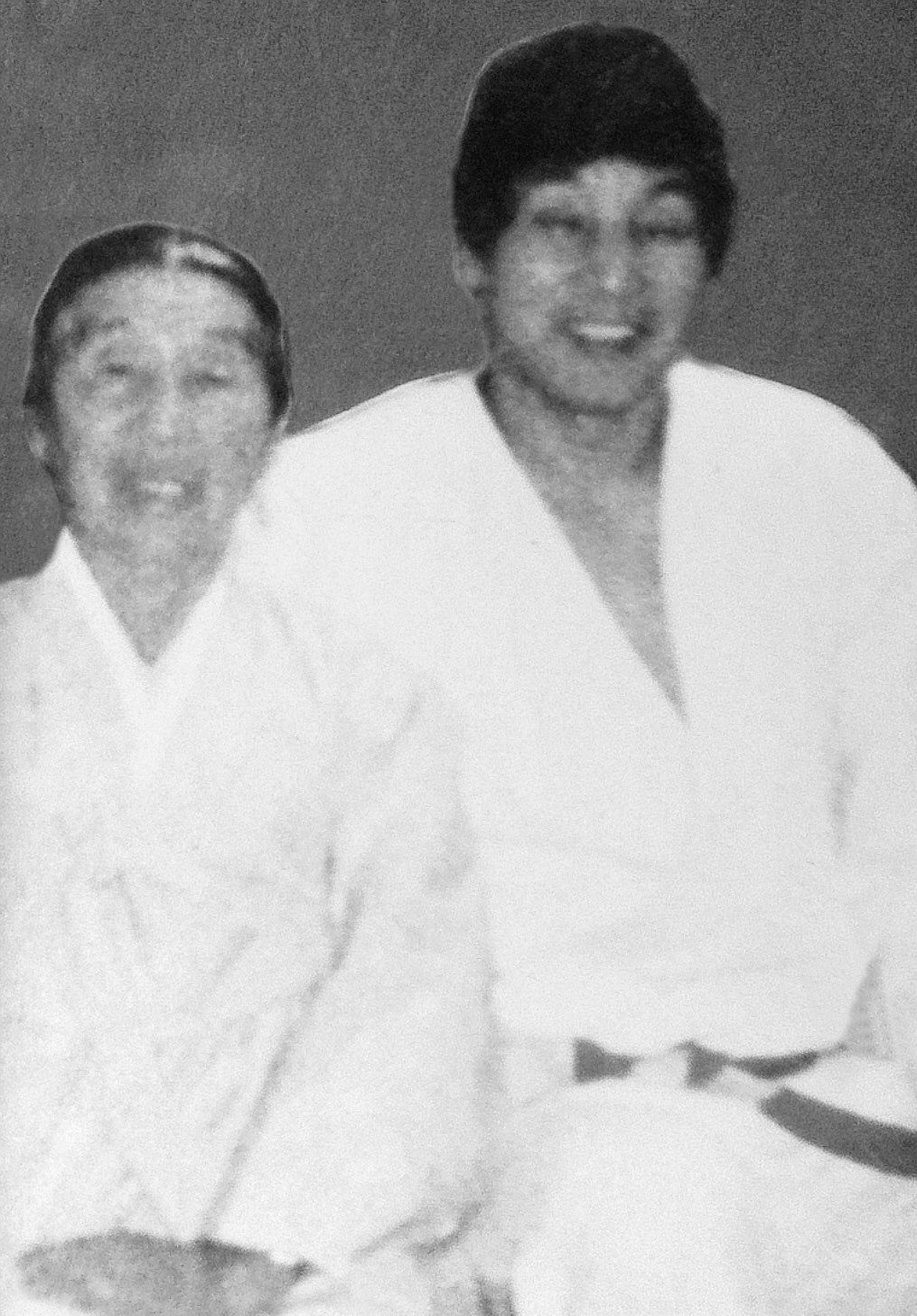
Kyu Ha Kim began his martial arts training in his home village at the age of five; his first teacher was his elder half-brother, Kyu Tae Kim. At fifteen, Kyu Ha Kim entered Tae Jon High School and began formal martial arts training under Han Sang Yul. The training was rigorous: two hours daily, six days a week, Monday through Saturday. Sundays were, “rest days,” although students often gathered to practice, “light uchi komi (Judo repetition fitting),” for a “few hours,” on Sunday afternoons! The training was undifferentiated by discipline and included a broad spectrum of martial arts techniques we would recognize today as Jui-Jitsu, Judo, or its Korean interpretation, Yudo, and Taekwondo (note: the name Taekwondo was not applied to the group of Korean striking martial arts from which it was formed until the late 1950’s). This approach continues today; Kyu Ha Kim’s Judo students practice striking techniques, both Judo striking and basic Taekwondo, and his Taekwondo students learn Judo falling technique and fundamental Judo throws. Kyu Ha Kim continued to train in this manner until his graduation from Tae Jon High School, at which time he was promoted to 1st-degree black belt. His promotion to 1st-degree black belt did not come easily, however. In spite of his dedication to the school’s demanding training regimen and his success in high school tournament competition, he failed his promotional test for 1st-degree black belt nine times before finally succeeding!
Korean Yudo (유도) College
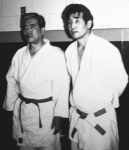
When Kyu Ha Kim graduated from high school the Korean War (1950-1953) was raging. Like many young Korean men, in spite of the 80% casualty rate, Kyu Ha Kim planned to join the army. Fortunately, his Judo instructor, Han Sang Yul, convinced him that his life’s path was in a different direction and that he should pursue a career as a martial arts teacher. Kyu Ha Kim followed his teacher’s advice and entered the Korean Yudo College, now Yong-In University, which he attended from 1954-1958. Founded in Sogong-dong in 1953 as a two-year college, The Korean Yudo College became recognized as a four-year institution in 1956 with the establishment of the Dae Myung School. The Korean Yudo College was the first college-level institution devoted to martial arts training in Asia. Its name was later changed to Yong-in University to reflect the addition of a full academic curriculum to the wide array of martial arts taught and practiced: Judo, Taekwondo, Hapkido, Kumdo, Kuksundo, Ssirium, etc. Admittance to the Yudo College was only granted to the most qualified black belt applicants. Kyu Ha Kim was among the first students accepted into the Korean Yudo College’s inaugural class, which originally numbered thirty-eight students, only twelve of whom graduated! The curriculum at the Korean Yudo College consisted of academic university classes and hour upon hour of rigorous martial arts training. The training was even more arduous than Kyu Ha Km experienced in high school, often up to three hours a day with high-level Yudoin (Yudo practitioners; equivalent to the Japanese term, Judoka). Students eschewed “tapping out,” the customary indication of submission when practicing groundwork and were regularly choked to unconsciousness! While enrolled at Yong-in University, Kyu Ha Kim studied under Grandmaster Jin Kyung Suk, who was among the highest-ranked Judo practitioners in Korea at that time.
Students lived at Yong-in University during the year and were only permitted to return to their homes during the summer recess. On one occasion, unhappy with his left-side Judo technique, within a few days of returning to his home, Kyu Ha Kim returned to the University to drill his left-side techniques exclusively for the balance of the summer!
Champion
In 1955, during his second semester at the Yudo College, Kyu Ha Kim qualified for the Korean National Judo Championships and was placed on the Chungnam province five-man Judo team (note: During this time, under Syngman Rhee, Korea’s first post-WWll President, martial arts competition between provinces was instituted as a means to foster Korean nationalism.). Kyu Ha Kim represented his province both as an individual and a team member. In 1958, he won the Korean National Judo Championship, as an individual and team member, a feat he repeated in 1960. Normally, students were promoted to 4th-degree black belt upon graduation from Yong-in University, however, in recognition of his two national championships, when he graduated in 1958; Kyu Ha Kim was promoted to 5th-degree black belt.
Kyu Ha Kim attended the Korean Yudo College during the aftermath of the Korean War. The years following the Korean War, on the heels of WW ll and the extended occupation and effort to colonize Korea by Japan (1910-1945), was a time of unimaginable loss and deprivation. The war which raged across the Manchurian peninsula resulted in hardships of every description, including widespread food shortages. Kyu Ha Kim’s family occupation as farmers spared them from much of the starvation experienced by so many of their countrymen, although he vividly recalls days of little if any, food. Families were often forced to abandon their homes to flee from advancing troops. At one point, Kyu Ha Kim’s entire village was destroyed and the surrounding countryside was reduced to ash by bombing and subsequent firestorm. Streets, damaged during the war, remained unpaved. The training hall where he spent hours every day did not escape damage. Glass was often broken out of windows, allowing snow to blow onto the mat in the winter. Fuel was scarce; the training hall often went unheated. The training hall was freezing in the winter and stifling hot in the summer. Eventually, the training hall was completely destroyed during a bombing run, only to be rebuilt by Kyu Ha Kim and his fellow students, determined to continue their training. Throughout and despite these harsh conditions, Kyu Ha Kim continued his training regimen throughout the war.
In 1959, Kyu Ha Kim was given the honor of returning to Yong-in University to teach Judo and was also invited by the Korean Air Force Academy to teach martial arts. By so doing, he became the first Judo instructor to teach at a Korean military academy. These events mark the beginning of Kyu Ha Kim’s more than a fifty-year career as a professional martial arts teacher. It was during this time that his students bestowed the title, “The Tree,” upon him when they found it virtually impossible to unbalance him during randori (free sparring)!
Taekwondo
It was also in 1959 when Kyu Ha Kim began formal training in Taekwondo to complement his training in Judo. Grandmaster Jin Kyung Suk, Kyu Ha Kim’s Judo teacher, recommended and introduced him to Grandmaster Hwang Ki, the founder of the Moo Do Kwan Tang Soo Do School. Grandmaster Hwang sent one of his best assistant instructors, Kyung Won Lee, to the Korean Air Force Academy to teach Tang Soo Do. Kyung Won Lee taught Kyu Ha Kim Tang Soo Do and Kyu Ha Kim taught Kyung Won Lee Judo. At the time Kyu Ha Kim began training, Grandmaster Hwang Ki referred to his art as Tang Soo Do (Grandmaster Hwang’s art underwent several name changes: Hwa Soo Do, Soo Bahk Do.). It was during this period of time when a number of Korean hard-style striking arts were integrated and named Taekwondo that a schism developed within Moo Doo Kwan Tang Soo Do. A number of senior practitioners elected to join the Taekwondo unification movement and a number of others, including Grandmaster Hwang, elected not to join. To this day, there remains a distinct martial art, Soo Bahk Do Moo Do Kwan, led by Grandmaster Hwang Ki’s son, Hwang Hyun Chul. That portion of Grandmaster Hwang Ki’s martial art that was integrated into Taekwondo is referred to as Moo Do Kwan Taekwondo, the form of Taekwondo practiced by Kyu Ha Kim’s students. Taekwondo is practiced in Kyu Ha Kim’s schools under the auspices of The World Taekwondo Federation (WTF).
In December of 1959, Kyu Ha Kim had the pleasure of engaging in a randori session with the giant Dutch martial arts luminary, Mr.Jon Bluming. Mr. Bluming trained in Judo, Karate, Iaido, and Jojutsu in Japan from 1959-1961. Mr. Bluming also visited the Philippines and Korea, where he met Kyu Ha Kim. Mr. Bluming is currently a 10th-degree black belt in Masutatsu Oyama’s tough kyokushinkai style of karate and a 9th-degree black belt in Judo. The encounter between Mr. Bluming and Kyu Ha Km is described in detail from Mr. Bluming’s point of view in an article in Journal of Combative Sport, November 1, 1999, Doing Judo at the Korean Yudo College, “The Day I Met Kyu Ha Kim.” The outcome of their randori session is best described by Jon Bluming,”…it was the last thing that was easy about Kim Kyu-Ha, for after that he completely vacuum-cleaned the mat with me, which convinced that, yes, this was the Korean champ.”
The United States
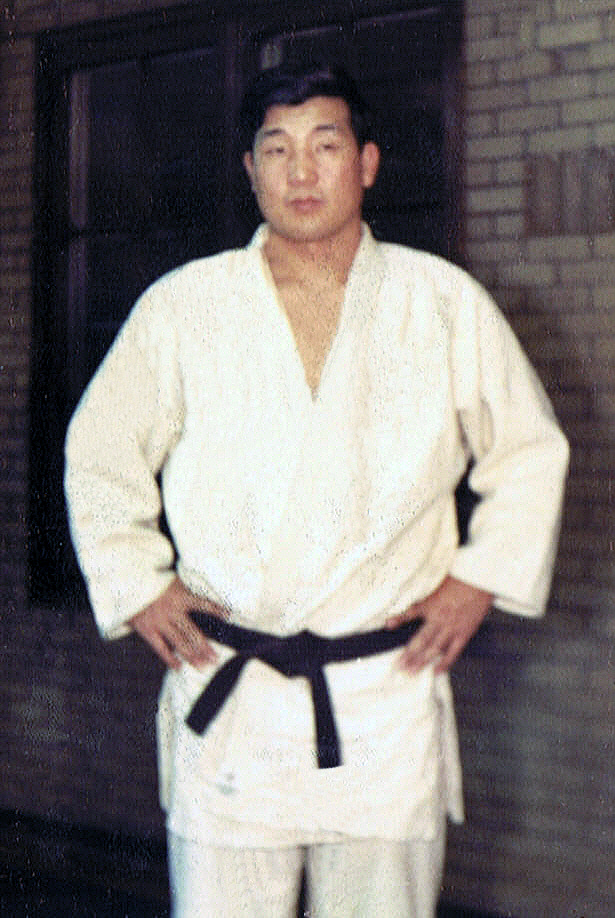
Kyu Ha Kim continued to teach at both Yong-in University and the Korean Air Force Academy until he was invited to visit the United States in 1961. Kyu Ha Kim was among the first wave of Korean martial arts masters to leave Korea to disseminate their arts to the world, a distinguished company which in the US includes such martial arts giants as Daeshik Kim, Chan-Yong Kim, and Jhoon Rhee. After a brief sojourn in New York City, Kyu Ha Kim spent a year in Oklahoma City, Oklahoma, before permanently settling in Pittsburgh.

Kyu Ha Kim’s initial exposure to the US included attendance at any number of Judo seminars and tournaments where he often found himself challenged by local Judoka, eager to test their skills against those of the two-time Korean Champion. On one such occasion, while attending a tournament at the US Air Force Academy, he was asked to,”take the line,” that is, engage in randori sequentially with a series of young Judoka. Kyu Ha Kim was able to easily overcome everyone with little apparent effort. When asked how he was able to do so with such ease, he replied,” Simple! I work harder than all of you!”
Life in Pittsburgh
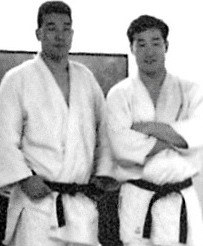
Upon his arrival in Pittsburgh, Kyu Ha Kim began teaching martial arts at a small dojo, The Pittsburgh Judo School, and the Young Men’s Hebrew Association (YMHA). In less than two years, he opened his own school, Kim’s Judo & Karate, in the South Hills area of Pittsburgh. In addition to teaching at his school, Kyu Ha Kim played a central role in organizing Judo and Taekwondo in Pennsylvania and on the East Coast. From 1964-1978, he was a member of the National Judo Promotion Board where he was instrumental in instituting a number of substantive changes to the Judo promotion process including the establishment of regional governing bodies with promotional authority. In 1965, Kyu Ha Kim became the first president of the Pennsylvania state Judo organization, Pennsylvania Judo, Inc., a post currently held by his son, Eugene Kim, a 6th-degree black belt in both Judo and Taekwondo.
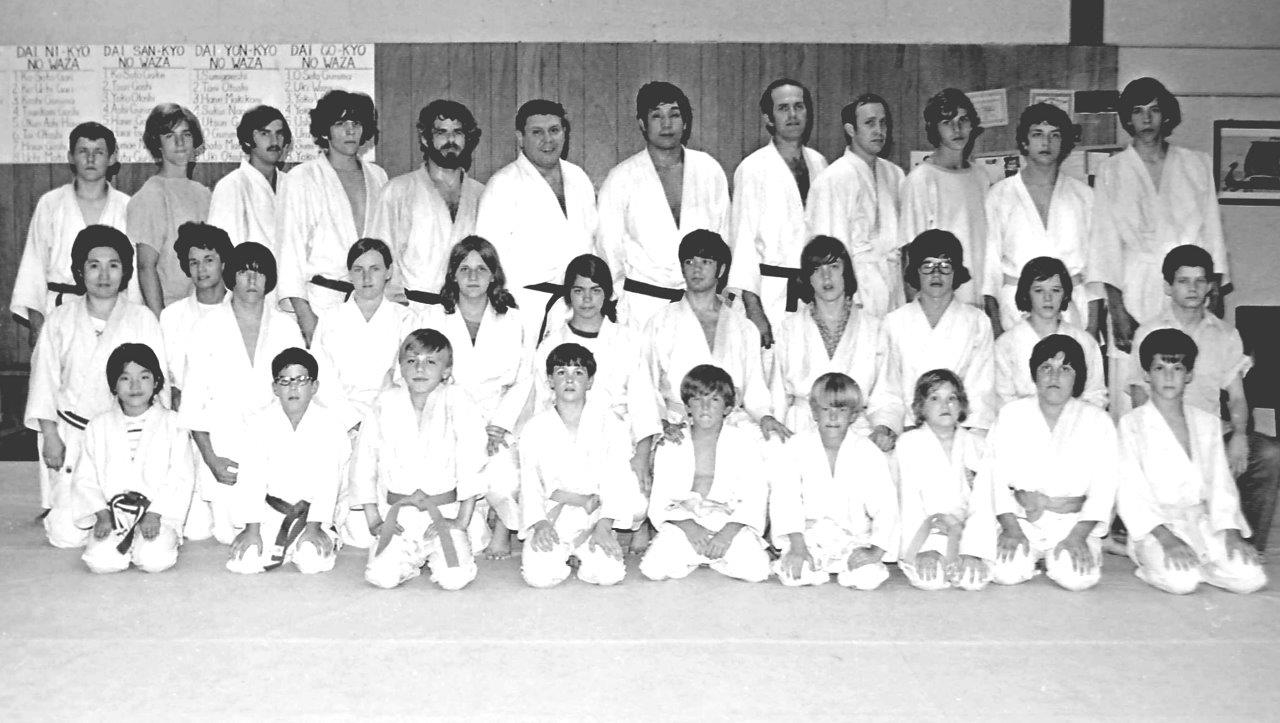
In 1972, Mr. Gary Goltz, an early student of Kyu Ha Kim at the YMHA and a freshman at the University of Pittsburgh petitioned the University to institute a Judo program. Mr.Goltz is now a Shichidan, 7th-degree black belt, and currently the president of the US Judo Association. As a result, Kyu Ha Kim was invited to teach credit courses in Judo, Taekwondo, and Jui-Jitsu by the University where he continues to teach over forty years later. In 1985, as coach of the University of Pittsburgh’s Judo team, Kyu Ha Kim was selected as the National Collegiate Judo Coach of the Year.
Legend
Although Kyu Ha Kim’s primary interest has always been teaching martial arts, he has also coached prominently at both the national and international level. He has been:
- Named as the US Judo Team Coach for the Pan American Games and World Championships is 1976 and 1977 respectively
- Appointed US National Judo Team Coach for the World Championships in Barcelona, Spain.
- In 1977, selected to coach the US Team at the first Kano Cup in Tokyo, Japan, a prestigious Judo tournament reserved for the top twenty Judo countries in the world.
- In 1979, elected the US Olympic Team Coach for the 1980 Olympic Games, which the US chose to boycott.
Kyu Ha Kim has taught literally hundreds of Judo and Taekwondo students and produced scores of state and national champions. The achievements of two students are of particular note: Ms. Cynthia Nicholas was an alternate on the 1996 Women’s Olympic Judo Team and Mr. Conor Driscoll, who contended for a spot on the Men’s Olympic Judo Team in 2008, and competed in the World Judo Championships in Tokyo, Japan in 2010 as a member of the US Team.
In 1994, Kyu Ha Kim became one of the first inductees into the newly formed United States Judo Hall of Fame as one of the ten most prominent influences on the development of Judo in the United States.
In May of 2000, the Korean Judo Association and the International Judo Federation promoted Kyu Ha Kim to the rank of KuDan, 9th-degree black belt, a rank few Judoka in the world have achieved. Kyu Ha Kim is the youngest individual in the history of Judo to be accorded this honor.
“Old Heart, No Good! New Heart, On Its Way!”
Early in his eighth decade, Kyu Ha Kim faced what was to be his greatest challenge. In 2007, his health began to deteriorate. As a result of a virus, he developed idiopathic cardiomyopathy, a degenerative heart condition. Eventually, his heart condition deteriorated to the point where, in July of 2007, his doctors elected to implant a pacemaker. This procedure, although initially successful, became complicated by a series of staph infections, which required him to spend weeks in the hospital. As his heart muscle continued to deteriorate, it became clear that a heart transplant had to be considered. The initial evaluation of Kyu Ha Kim as a heart transplant candidate was not encouraging, notwithstanding his extraordinary level of fitness. His age at the time, seventy-three, was considered a deterrent. This fact, coupled with the scarcity of donor hearts-the Mayo Clinic estimates the number of individuals increases by 4,000 each day-made a heart transplant unlikely.
Although the prognosis was bleak, Kyu Ha Kim and his family refused to surrender to fate and eventually found their way to to the University of Pittsburgh Medical Center and a wonderful team of doctors led by his surgeon, Dr. Christian Bermudez. The medical staff conducted yet another battery of tests and concluded that in spite of his age, Kyu Ha Km’s physical condition made him an excellent candidate for a heart transplant. According to Dr. Bermudez, only a tiny fraction of potential heart transplant patients with circumstances similar to Kyu Ha Kim successfully undergo this procedure. In 1980, of the twelve hundred procedures performed at UPMC, only fifteen to twenty fell into this category. Although many heart transplant recipients must wait weeks and months for a donor’s heart, fortunately, after only two weeks on the heart transplant waiting list, a donor’s heart became available. Although the donor’s heart was less than perfect-it exhibited signs of cardiovascular disease-Kyu Ha Km elected, in his words, ” to take a chance,” and undergo the heart transplantation procedure. Throughout this ordeal, Kyu Ha Kim never lost his equanimity and sense of humor. In fact, he informed a senior student, Master Chuck Schmidt of his imminent surgery by stating, “Old heart, no good. New heart, on its way!”
On June 28, 2008, Kyu Ha Kim underwent heart transplant surgery, a ten-hour operation. The evening after the surgery, he was alert and hungry! The following day, the medical staff had him standing. In just over a month following his heart transplantation procedure, Kyu Ha Kim returned to his school and to the mat.
Dr. Bermudez attributed the success of Kyu Ha Kim’s heart transplant to his remarkable physical condition, a product of his lifelong commitment to martial arts training. Those who know him well understand that it is equally true that his survival and recovery were due in no small measure to his unconquerable spirit.
Today, more than five years after heart transplant surgery, Kyu Ha Kim has returned to his life’s calling and teaches a full complement of martial arts classes at his Brentwood school and the University of Pittsburgh. Each day finds him training, teaching and inspiring another generation of martial artists. In an age when so many martial artists lay claim to lofty titles, Kyu Ha Kim is among the few who richly deserve the title, Grandmaster.
–Master Christopher D. Moore, September 2013
May 14, 2021
Today we lost an extraordinary man, Grandmaster Kyu Ha Kim. A man of rare accomplishment: Kudan, 9th Degree black belt in Judo and Paldan, 8th Degree black belt in Taekwondo; recognized worldwide as an indomitable champion and consummate teacher. Grandmaster Kim’s accomplishments in the martial arts world are the stuff of legend. As a martial artist, Grandmaster Kim towered over his contemporaries; as a human being, he was quite simply among the best of men. As his student for nearly thirty years, I was witness to his peerless skill and iron discipline, which were only eclipsed by his humanity, so evident in his countless acts of kindness. The years I spent as his student forged me as a martial artist, teacher and, most importantly, man.It is left to those of us who had the good fortune to be his students to carry on his legacy, to practice and teach the martial arts he loved in a manner worthy of his memory.
On May 17th, Grandmaster Kyu Ha Kim was posthumously promoted to Judan,10th degree black belt, the highest possible rank in the art of Judo by the United States Judo Association.
(Author’s note: Grandmaster Kim speaks about his many accomplishments with great reluctance. It took innumerable discussions over the course of years and input from family members, former students and colleagues to complete the narrative of GM Kim’s life. Thanks to everyone. Special thanks are due to GM Chan-Yong Kim for his help in filling in the blanks! CDM)
All photographs are courtesy of Mr. Gary Goltz.
